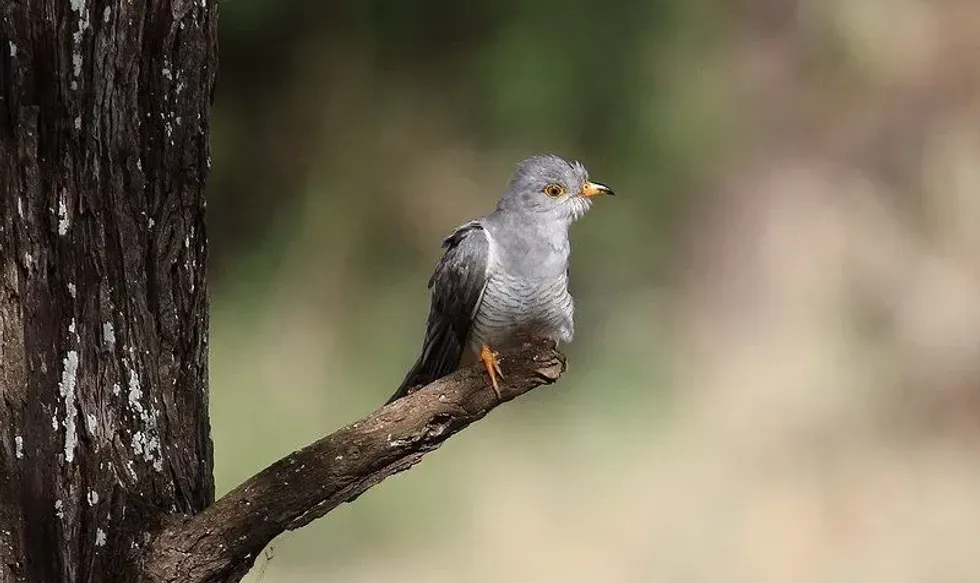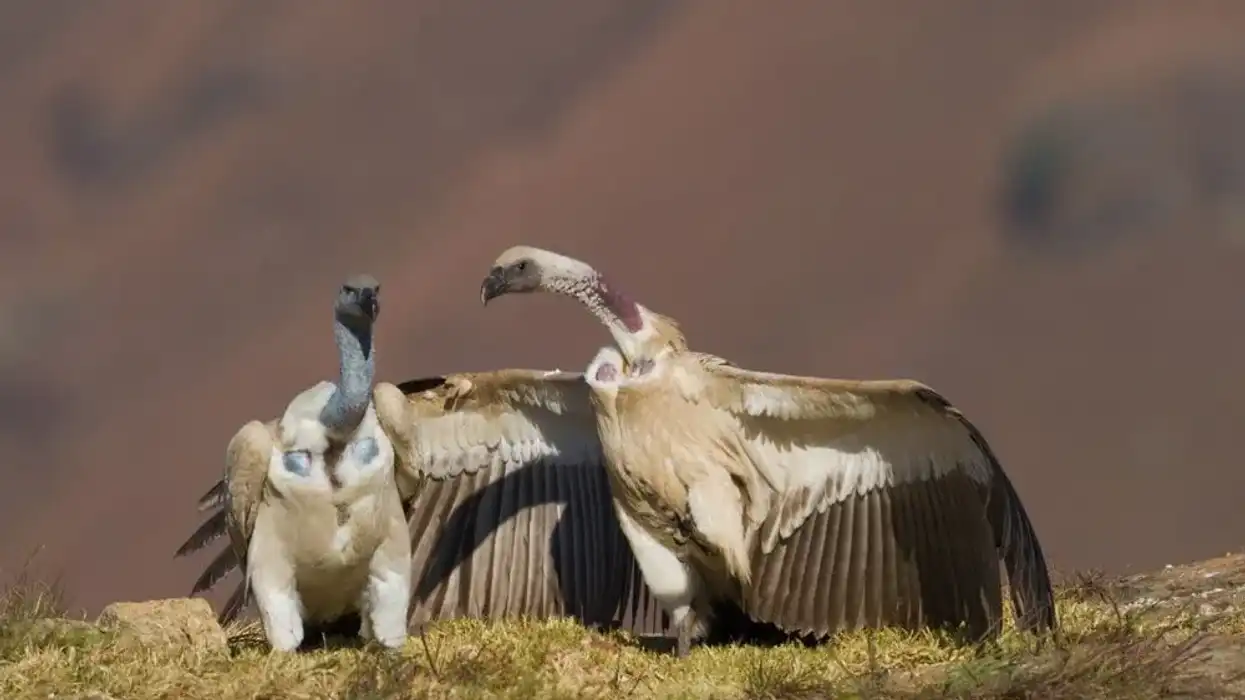The African cuckoo or the Cuculus gularis come from the Cuculidae family and belong to the Cuculiformes order. They share similar looks to the common cuckoo and are even closely related.
The only difference lies between their calls. This bird species has a large range, is found throughout sub-Saharan Africa, especially in South Africa, and migrates within the continent.
However, its population does not exist in Somalia and parts of the Republic of Congo. Its powerful dashing flight makes it look like a bird of prey but although they are good fliers, they do not fly over large distances.
The adult male is grayish-white or an ash color with a yellow beak and a long barred tail. The adult female differs from the male by the red-tinged neck and upper breast.
Breeding patterns of this brood species during the rainy season and once again, disperse after the breeding season. The African cuckoo Cuculus gularis is a brood parasite which means that the female bird will lay its eggs in the nests of other birds instead of its own nest.
Sometimes, she will remove the eggs of the hosts and place hers in the nest instead.
Since they are solitary birds, they prefer habitats like savannas covered with acacia trees and open woodlands, making sure to avoid evergreen forests. Often foraging through thickets and foliage, they feed on hairy caterpillars, beetles, termites, grasshoppers, and winged ants.
If you'd like to learn more about other cuckoo birds, check out our black-billed cuckoo facts and Indian cuckoo facts!
African Cuckoo Interesting Facts
What type of animal is an African cuckoo?
Scientifically called Cuculus gularis, the bird is a brood parasite that lays its eggs in the nest of another target bird. It is closely related to the common cuckoo and is an intra-African migrant.
What class of animal does an African cuckoo belong to?
The African cuckoo belongs to the class of aves and is part of the Cuculidae family.
How many African cuckoos are there in the world?
The precise number of African cuckoos around the world is not known but given their Least Concern status by the IUCN, they do not face any major threat. In fact, their range and distribution are quite common in the African subcontinent.
Where does an African cuckoo live?
As their name goes, the distribution of this brood bird occurs in various countries of the African subcontinent especially South Africa and is common around the world. However, they are uncommon in eastern Africa. They live in the acacia savannah and open woodland, avoiding thick and dense forests. This bird species prefer a tropical to temperate climate.
What is an African cuckoo's habitat?
This bird prefers living in open woodland and in savannas with lots of acacia trees. They tend to avoid evergreen forests. They are also absent from dense forests and arid regions. Given their parasite nature, the female cuckoo lays her eggs in the existing nests of other birds while the male distracts the host species.
Who do African cuckoos live with?
The brood African cuckoo Cuculus gularis is solitary so it lives alone. The adult male can be territorial and in southern Africa, they tend to occupy a particular territory and drive off the other cuckoo birds living there.
How long does an African cuckoo live?
Since it is part of the species of cuckoo, these birds can live up to 18 years.
How do they reproduce?
The breeding period of this migrant from Africa coincides with the rainy season and it varies according to the range. The Cuculus gularis is a brood parasite-they do not build their own nests.
Rather, they occupy the nests of other bird species and the female lays her eggs in them when the adult male distracts the owners of the nest.
They target the nests of hosts whose eggs resemble their own in terms of color and size. The female may remove the existing eggs before laying her own.
The eggs of the African cuckoo bird are incubated by the hosts for about 11-17 days and raise the chicks as their own.
This is why these cuckoos often lay their eggs in the nest of the fork-tailed drongos or yellow-billed shrikes. The cuckoo chicks may at times also remove the eggs or new chicks of the hosts if the mother fails to return.
What is their conservation status?
The IUCN has currently evaluated them as being of Least Concern, as they're quite common across the world and their distribution and range are stable.
African Cuckoo Fun Facts
What do African cuckoos look like?
These African cuckoo birds are medium-sized and are ash in color or can sometimes even be gray. The heads and plumage are grayish white in both sexes. The eye is yellow in the adult male and brown in the adult female.
The base of their beak, legs, and feet are yellow. The wings of these birds are also in a pointed shape contributing to their powerful flight. The underside of the tail is also seen to have dark barred markings.
How cute are they?
Given their grayish plumage, these birds rook rather plain and dull. Hence, they do not look appealing and are not very cute either.
How do they communicate?
The unique calls of this brood parasite are said to help in communicating with each other.
How big is an African cuckoo?
This brood cuckoo bird, which is native to north and south Africa, is 12.5 in (31.7 cm) lengthwise and is two times bigger than a pigeon.
How fast can an African cuckoo fly?
Although the flight speed of this bird species is not known, they are fast and powerful fliers.
How much does an African cuckoo weigh?
The African cuckoo weighs about 3.8 oz (107.7 g). Adult males are slightly bigger than the female cuckoos.
What are the male and female names of the species?
These species do not have a specific male and female name. They go by their common name African cuckoo or their scientific Cuculus gularis.
What would you call a baby African cuckoo?
The baby of the African cuckoo Cuculus gularis is called a chick. Juveniles are seen to have a blackish-white upper body with heavily barred lower parts.
What do they eat?
These birds are mostly insectivores and eat termites, ants, grasshoppers, hairy or smooth caterpillars, beetles and even the eggs of smaller birds.
Are they dangerous?
They are more dangerous to other bird species than humans. These birds are often called brood parasites which means that they rely on other birds to look after their chicks.
The way they go about is ruthless. The female at times pushes off the eggs from the nest of the target host before laying her own. This can lead to a reduction in the population of the target host species.
Would they make a good pet?
Cuckoos are wild animals and therefore, it is illegal to keep them as pets. Moreover, their shy nature and loud calls would not make them exciting pets.
Did you know...
The male African cuckoo or the Cuculus gularis often attempts to court the female by offering her a caterpillar. He even tries to woo her by bobbing his head with his tail raised up and wings slightly open.
What does the African cuckoo sound like?
The African cuckoo call is quite unique. The male bird makes an 'ou-ou' sound while the female makes a more 'kii-kii' sound. Next time you visit a bird sanctuary, pay close attention to their calls and see if you can distinguish between them. They are known to be very vocal during the breeding season.
What does a cuckoo symbolize?
In many cultures, it is believed that the call of the cuckoo symbolizes new fate or the unfolding of a new event in your life. If you are doing something and hear the call of the cuckoo, it is said to continue that particular activity throughout the year as it is highly beneficial.
In short, their call is said to bring good luck!
Here at Kidadl, we have carefully created lots of interesting family-friendly animal facts for everyone to discover! For more relatable content, check out these black cuckoo facts and yellow-billed cuckoo facts for kids.
You can even occupy yourself at home by coloring in one of our free printable African cuckoo bird coloring pages.










